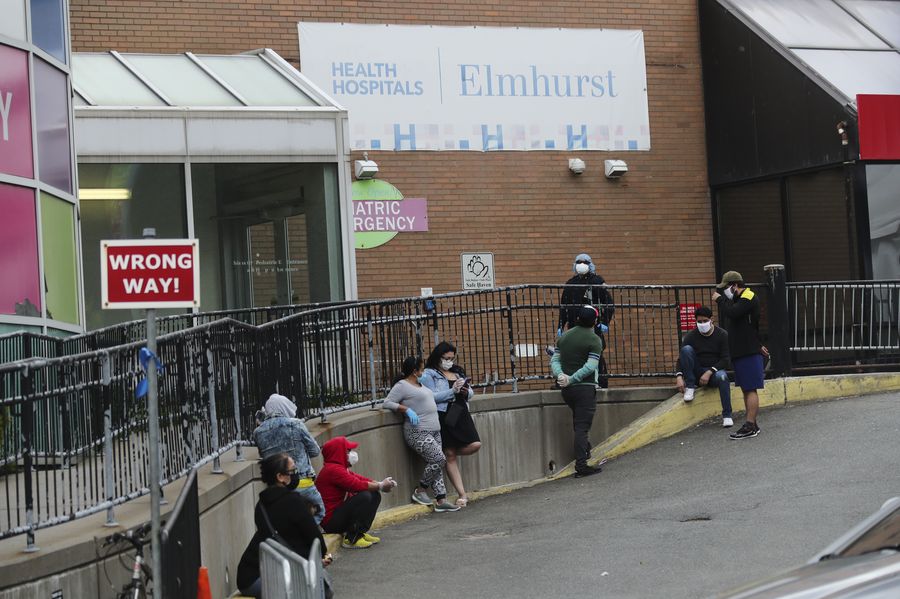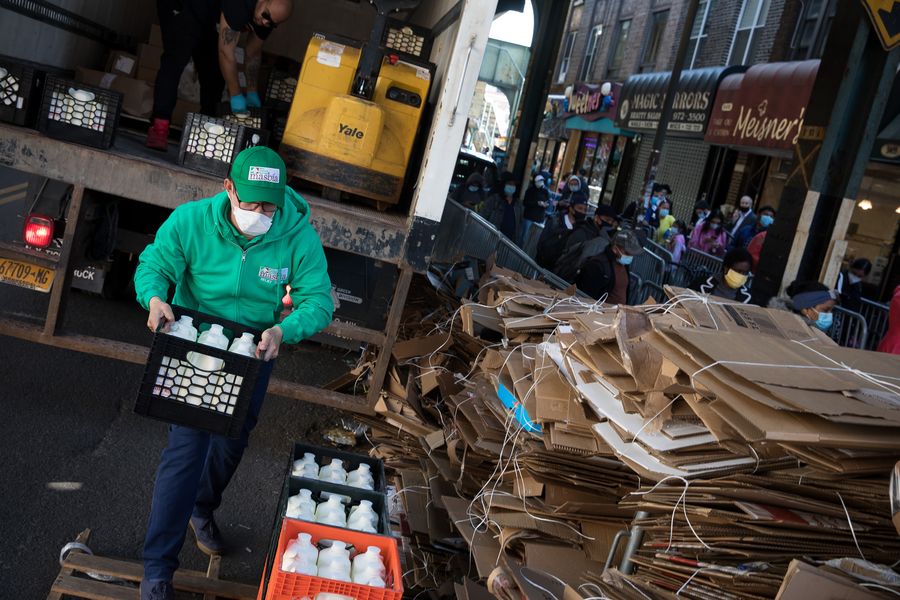
People wait to receive food at a food distribution site in the Brooklyn borough of New York, the United States, May 14, 2020. (Photo by Michael Nagle/Xinhua)
As some parts of New York state are reopening following a phased strategy, New York City still has to wait as it has
- not met the requirements for reopening
- limited testing capacity
- been embroiled in an ever-growing partisan fight in the nation at a time when cooperation is needed the most
NEW YORK, May 17 (Xinhua) -- Life came to a grinding halt for about 8.3 million residents in New York City when a statewide "PAUSE" order went into effect to curb the spread of COVID-19 nearly two months ago. So far, schools, businesses, and Broadway theaters have been shuttered, with health care workers fighting tirelessly to save lives in overwhelmed hospitals.
On Friday, five regions in the central and northern parts of New York state reopened following a phased strategy. Those regions, largely remote and account for less than one-fifth of the state's population, have not been hit hard by the pandemic.
New York City still has to wait, as it has not met the requirements for reopening in new hospitalization, share of total hospital beds and ICU beds available -- three of the seven benchmarks set by the state government.
Mayor Bill de Blasio said this month that the city would not see eased restrictions before June, and a true reopening will be "a few months away at minimum."
LIMITED TESTING CAPACITY
Despite a flattened curve, the data in New York City remain staggering. By Saturday afternoon, the city's health department has reported 189,031 cases, more than those of countries including France and Germany. A death toll of 20,576 accounts for nearly a quarter of the national total.

Healthcare workers wheel a patient into Brooklyn Hospital Center in Brooklyn of New York, the United States, on May 11, 2020. (Xinhua/Wang Ying)
"While the (daily new) case count appears to be decreasing, there is still a need for it to go lower, and to have the ability to detect and trace the contacts of cases to prevent a major resurgence in the virus," Jeff Schlegelmilch, deputy director for the National Center for Disaster Preparedness at Columbia University's Earth Institute, told Xinhua.
"In a densely populated place like New York City, none of these things are simple, and all of this needs to be done at a large scale with quick reaction to changes in conditions," he noted.
Experts and officials underlined the significance of testing at the beginning of the crisis in early March. Both the mayor and New York Governor Andrew Cuomo have repeatedly vowed to expand testing capacity, especially in lower-income and minority communities.
After more than two months' efforts, however, the supply still falls short of the demand. "Lack of widespread testing was our Achilles' heel from day one," said de Blasio on Thursday. "We're still playing catch-up."
Also on Thursday, the mayor announced that any person with COVID-19 symptoms as well as anyone who has been in close contact with a confirmed case is now eligible to receive a test in New York City, which means these basic containment measures have never been fully conducted in the epicenter of the pandemic.

People wait to take COVID-19 tests outside Elmhurst Hospital in New York, the United States, May 4, 2020. (Xinhua/Wang Ying)
Notably, the importance of contact tracing was largely ignored or deemed a mission impossible by local officials. During a press briefing on April 3, New York City's Health Department Commissioner Oxiris Barbot said contact tracing was "not a good use of our resources" and the city has gone "past the point of contact tracing."
It was not until late April that both Cuomo and de Blasio announced their plans to hire thousands of people to get trained to be contact tracers.
The tardy response at the local level reflects the whole picture of the nation. "The United States in general is behind the curve, literally and figuratively, in terms of testing and contact tracing," said Schlegelmilch.
PARTISAN FIGHT
The city has also been embroiled in an ever-growing partisan fight in the nation at a time when cooperation is needed the most. De Blasio, a Democrat, has repeatedly lashed out at President Donald Trump for his reluctance to lend a helping hand to his home city.
"Unfortunately the help we needed from the federal government never was there in the beginning, still isn't here," said de Blasio on Thursday's briefing.
"The only limitation we face is the amount of lab capacity available. And again, we need the federal government to step up," he added.

New York State Governor Andrew Cuomo provides a coronavirus update during a press briefing in Albany of New York State, the United States, May 15, 2020. (Mike Groll/Office of Governor Andrew M. Cuomo/Handout via Xinhua)
De Blasio and the Democrat Governor Cuomo both expressed support for a 3-trillion-U.S. dollar coronavirus stimulus bill passed by the House of Representatives on Friday, which could allocate much more funding to New York state and local governments than the previously passed CARES Act.
"Right now, if we don't get a massive infusion of federal support, we cannot go through this recovery. We cannot get our city back on our feet because we won't be able to pay for the basics," said the mayor on Thursday.
But the Republican-held Senate has thrown cold water on the House Democrats-proposed bill, making it unlikely to be approved eventually. In a tweet posted on Friday, Senate Majority Leader Mitch McConnell called it a "3 trillion left-wing wish list."
"NEW NORMAL"
Meanwhile, a lack of coordinated government efforts in the country's reopening process complicates New York City's recovery. According to CNN, around 48 states will have total or partial reopening by Sunday, some of them have not seen essential mitigation of COVID-19 within itself.
"Areas of the country that are opening sooner than they should will almost certainly have new transmission of the virus, which will spill over into other parts of the country," said Schlegelmilch.
Even after the city reopens one day, New Yorkers will have to accept a "new normal" in their lifestyle until a vaccine or effective treatment is widely available.
Schlegelmilch believes there will "almost certainly be some kind of social distancing in place" for at least the next 12-18 months, and possibly longer.

A chef carries milk donated by Bethel Creamery at a food distribution site in the Brooklyn borough of New York, United States, May 14, 2020. (Photo by Michael Nagle/Xinhua)
"The extent of this will depend on a lot of varying conditions, so we need to be prepared to reinstate and relax certain measures as conditions change," he said.
Steven Cohen, senior vice dean of Columbia's School of Professional Studies, said that tourism would probably the slowest industry in New York to recover as "it will take a while before people have the confidence to come back."
Just like the surge of security screenings in New York airports after 9/11, there will be more "biological scanning to make sure people don't have pandemic diseases" in the future, said the professor at a Zoom briefing with reporters on Friday.
"So we're gonna reopen first with testing and tracing and isolation until the prevention and the cure will be discovered," said Cohen. "Right now, we're all afraid. But eventually, our fear will go away and the risk level will become tolerable." ■



